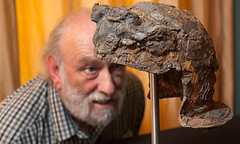
PREV ARTICLE
NEXT ARTICLE
FULL ISSUE
PREV FULL ISSUE
CONSERVATORS PIECE TOGETHER A ROMAN CAVALRY HELMETDavid Sundman writes: This is pretty neat. It's not entirely clear to me from reading this whether the coins were originally in the helmet, or whether the helmet was just another part of the find.
The work has occupied a team of conservators for years. The arguments about the mystery of such a high status object - possibly buried in the year of the Roman invasion of Britain, together with a mass of Roman and British coins and guarded by three dead dogs - will last much longer. Even after thousands of hours of work by conservator Marilyn Hockey and her team, the metal is too badly corroded to recover its original glitter. Although it is a unique find in Britain because most of the thin silver-gilt plating survives, and an exceptionally early example from anywhere in the Roman empire, the Hallaton helmet will never be as seductively beautiful as the Crosby Garrett helmet, excavated in Cumbria and controversially auctioned for £2m at Christies in 2010. The original owner would have shone in the sun like a god when he appeared on horseback wearing the helmet, of elaborately decorated silver over an iron core. Such objects were costly pieces of swagger never intended for practical use, but often given as rewards for exceptional service - in this case a gift of imperial quality. It was when Ken Wallace, a retired teacher and member of a local field archaeology group, saw a lifesize silver human ear in the mud in 2001, that he knew an already astonishing hoard had yielded up something extraordinary. He and other amateur archaeologists from the Hallaton Fieldwork Group found some pieces of Roman pottery on a low hill outside their village in 2000. Wallace returned with his metal detector, and started turning up coins - at which point he heroically stopped digging and called in the experts, including archaeologists from the British Museum and Leicester university. The site is now believed a major British hilltop ritual enclosure, protected by an east-facing ditch. The unearthed treasure was, in Wallace's words, "jaw-dropping". It included one of the largest hoards of Iron Age coins, more than 5,000 pieces of Roman and British gold and silver - including the oldest Roman coin ever found in Britain, a heavily worn pre-imperial denarius minted in 250 BC.
To read the complete article, see:
Unique Roman cavalry helmet pieced together 10 years after discovery
(www.guardian.co.uk/uk/2012/jan/10/unique The Numismatic Bibliomania Society is a non-profit organization promoting numismatic literature. See our web site at coinbooks.org. To submit items for publication in The E-Sylum, write to the Editor at this address: whomren@gmail.com To subscribe go to: https://my.binhost.com/lists/listinfo/esylum All Rights Reserved. NBS Home Page Contact the NBS webmaster 
|
